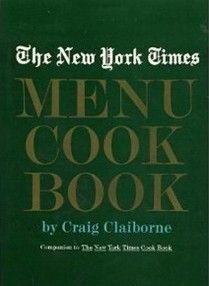Advertisement


New York Times Menu Cookbook

says
With over 1200 new recipes and 400 menus, The New York Times Menu Cookbook is a behemoth accomplishment from culinary icon Craig Claiborne. The menus are a guide to any occasion, from a simple barbecue to a formal banquet, all from one of the most trusted names in food.
from the publisher
A menu is a fascinating thing. In the proper perspective it deals with har monies and values that are totally absorbing, and there are, perhaps, more dimensions to it than the casual diner is ever aware of. In its simplest form the considerations of a well-planned menu are three—texture, flavor and color. Repetition of either in the course of one meal is anathema to the whole concept.
It is a commonplace that if a custard pie of a savory sort is served in the course of a meal, it would not logically be followed by a custard or pie of any sort. If the soup that begins the meal is watercress, the green should be eschewed in the salad.
In a similar sense, if cheese is a prominent ingredient in the meal's main course, the service of cheese should be avoided later. If the meal has been altogether heavy along the lines of a hearty stew and several courses, it would be best to select an ice or sherbet in preference to ice cream or a heavier dessert to end the meal.
Contrasts in color within the course of a meal are wholly desirable, al though time was at the end of World War I when monochromatic meals were fashionable in certain European circles. One such meal, contrived to be mono- chromatically red, began with smoked salmon, followed by a cold rose-tinted cherry soup, rare roast beef with a hot purée of beets (blended with mashed potatoes), sliced tomato salad, a centerpiece of radishes and, finally, raspberry sherbet topped with red ripe strawberries. The whole meal was served on red china on red tablecloths in a red room, and it sounds absolutely awful. There is a certain humor in the fact that during a green meal in the same period Roquefort cheese appeared with the salad.
Perhaps the most interesting menus ever conceived are those that ap peared during the siege of Paris. Almost anything that walked or crawled was considered edible, and the zoo is said to have been a prime and protean source for food. Thus a menu served on Christmas Day, in 1870, at the Café Voisin, rue Saint Honore, included stuffed donkey's head, elephant consomme, roast camel and jugged kangaroo.
It is fervently hoped that the menus in this book will be of value to the reader. There are more than four hundred of them in the menu section, and they embrace special dinners, international meals, simple suppers and menus for everyday dining.
But this is far more than a book of menus. It is a companion volume to The New York Times Cook Book, published in 1961. That edition contained nearly fifteen hundred recipes that had appeared in The New York Times during the decade 1950-1960. This menu cook book contains more than twelve hundred recipes culled from the thousands printed in the newspaper from 1960 to 1966. These are the best of the lot. Asterisks in the menu section indicate those dishes for which recipes may be found elsewhere in the book.
Like the recipes in The New York Times Cook Book, the recipes herein are derived from endless sources. Some are from international books on food, others from friends and many created in my own home and in The New York Times test kitchen. In several of the finest French recipes found here the hand of Pierre Franey, former chef at New York's famed Le Pavilion restaurant and now a vice president of Howard Johnson, can be discerned. I have spent count less pleasant hours working and discussing food with him in the kitchen of my East Hampton home.
Most popular
- Original Publisher
- HarperCollins
- Date of publication
- 1966
- ISBN
- 006010791x
Advertisement